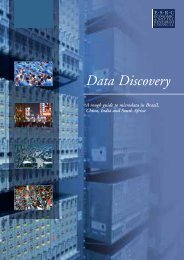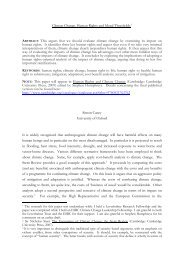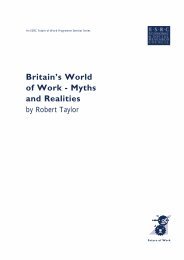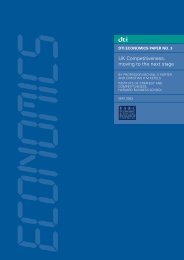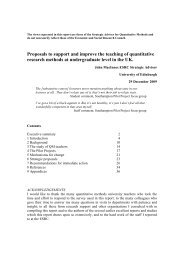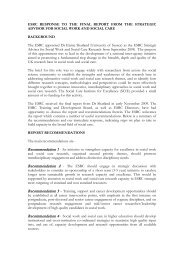How people use and 'misuse' buildings - ESRC
How people use and 'misuse' buildings - ESRC
How people use and 'misuse' buildings - ESRC
Create successful ePaper yourself
Turn your PDF publications into a flip-book with our unique Google optimized e-Paper software.
<strong>ESRC</strong> Seminar Series<br />
Mapping the public policy l<strong>and</strong>scape<br />
<strong>How</strong> <strong>people</strong> <strong>use</strong> <strong>and</strong> ‘mis<strong>use</strong>’ <strong>buildings</strong>
Foreword<br />
This seminar on how <strong>people</strong> <strong>use</strong> <strong>and</strong> ‘mis<strong>use</strong>’ <strong>buildings</strong> was organised by the Economic <strong>and</strong> Social Research<br />
Council (<strong>ESRC</strong>) <strong>and</strong> the Technology Strategy Board.The seminar explored how collaborative physical science<br />
<strong>and</strong> social science research can contribute to Government <strong>and</strong> industry efforts to cut carbon emissions from<br />
<strong>buildings</strong>, <strong>and</strong> is the second in a series looking at the relationship between <strong>people</strong> <strong>and</strong> technology.<br />
Addressing energy <strong>use</strong> is a top priority concern for Government, not only beca<strong>use</strong> of its impact on climate change, but<br />
also beca<strong>use</strong> security of supply <strong>and</strong> energy independence are matters of vital national interest. Buildings account for 45<br />
per cent of total UK energy <strong>use</strong>, the equivalent of all transport <strong>and</strong> manufacturing combined. <strong>How</strong>ever, despite high-profile<br />
publicity campaigns <strong>and</strong> the introduction of efficiency measures, building energy consumption continues to rise.<br />
Twenty-seven per cent of carbon emissions come from domestic <strong>buildings</strong> – twice that of commercial <strong>and</strong> public <strong>buildings</strong><br />
<strong>and</strong> five times that of industrial <strong>buildings</strong>.The Government has targets for all new homes to be zero carbon by 2016, but<br />
existing <strong>buildings</strong>, most of which will still be st<strong>and</strong>ing in 2050, will need to be radically refurbished if we are to meet<br />
national <strong>and</strong> international emissions targets.<br />
Although many of the required technologies – insulation, efficient heat sources <strong>and</strong> digital controls – already exist, they are<br />
not yet widely deployed. Performance, cost-effectiveness <strong>and</strong> usability all need to be improved. When they are installed,<br />
the occupants of <strong>buildings</strong> do not always behave in the way that designers expect.<br />
More research is needed to find out precisely how <strong>people</strong> respond to technological innovation, <strong>and</strong> to re-examine the<br />
notion of ‘comfort’ which is often taken for granted in the design <strong>and</strong> building of our home <strong>and</strong> working environments.<br />
This seminar provided a showcase for innovative inter-disciplinary research, which demonstrates the value of close<br />
collaboration between the physical <strong>and</strong> social sciences in the field of energy efficiency. It also flagged up new areas for<br />
future research.<br />
The meeting provided an opportunity for a lively debate between senior researchers from building engineering <strong>and</strong> a<br />
range of social science disciplines <strong>and</strong> representatives of Government, innovative industries, NGOs <strong>and</strong> policy think-tanks.<br />
Professor Ian Diamond AcSS<br />
Chief Executive<br />
Economic <strong>and</strong> Social Research Council<br />
Mr Iain Gray<br />
Chief Executive<br />
Technology Strategy Board
<strong>How</strong> <strong>people</strong> <strong>use</strong> <strong>and</strong> ‘mis<strong>use</strong>’ <strong>buildings</strong><br />
The researchers<br />
PROFESSOR KEVIN LOMAS, Department of Civil <strong>and</strong> Building Engineering University of Loughborough,<br />
Leverhulme Research Fellow <strong>and</strong> Visiting Fellow, University of Cambridge.<br />
DR DAVID SHIPWORTH, Reader in Energy <strong>and</strong> the Built Environment, University College, London.<br />
PROFESSOR ELIZABETH SHOVE, Department of Sociology, University of Lancaster.<br />
POLICY PERSPECTIVE: PROFESSOR MICHAEL KELLY, CHIEF SCIENTIFIC ADVISER,<br />
Department of Communities <strong>and</strong> Local Government.<br />
PROFESSOR DAVID UZZELL, SEMINAR CHAIRMAN, Department of Psychology, University of Surrey.<br />
<strong>ESRC</strong> Seminar Series Mapping the public policy l<strong>and</strong>scape<br />
<strong>How</strong> <strong>people</strong> <strong>use</strong> <strong>and</strong> ‘mis<strong>use</strong>’ <strong>buildings</strong><br />
1
Executive Summary<br />
Introduction<br />
One of the key means of meeting national <strong>and</strong> international emissions targets by 2050 is to reduce<br />
energy consumption in <strong>buildings</strong>. Buildings represent nearly half of total UK carbon emissions, equal to<br />
the environmental impact of the transport <strong>and</strong> manufacturing sectors combined. And despite advances<br />
in technology <strong>and</strong> publicity campaigns, <strong>buildings</strong> energy consumption continues to rise.<br />
Twenty-seven per cent of carbon emissions come from domestic <strong>buildings</strong> – twice the emissions of<br />
commercial <strong>and</strong> public <strong>buildings</strong> <strong>and</strong> five times that of industrial <strong>buildings</strong>.The domestic sector is clearly<br />
crucial, but policy initiatives have so far concentrated on persuading developers to produce new homes<br />
with a lower impact. More effort is required to reduce energy consumption in existing housing stock.<br />
This seminar took place in the context of the Government’s decision to invest up to £30m in new research<br />
to help the construction industry deliver <strong>buildings</strong> with a much lower environmental impact.The aim of the<br />
research, which will be funded jointly by the Technology Strategy Board, industry <strong>and</strong> other funding agencies,<br />
is to pave the way for innovative building design to meet the challenge of future climate change.<br />
As a further boost, the Technology Strategy Board’s Low Impact Buildings Innovation Platform is launching<br />
a £10m competition for innovative solutions to improve the energy efficiency of existing housing stock.<br />
Companies will be invited to bid for contracts to work with social l<strong>and</strong>lords, to refurbish at least 50 prototype<br />
ho<strong>use</strong>s of all types <strong>and</strong> evaluate their environmental performance.<br />
The UK Government has targets for all new homes to be zero carbon by 2016 <strong>and</strong> commercial <strong>and</strong> public<br />
<strong>buildings</strong> by 2019. <strong>How</strong>ever, even though new <strong>buildings</strong> have an economic <strong>and</strong> environmental impact, they<br />
constitute only a fraction of the building stock. Most of the UK’s 25m current housing was constructed<br />
decades ago before oil crises <strong>and</strong> global warming became issues – <strong>and</strong> most of them will still be st<strong>and</strong>ing in<br />
40 years’ time.This raises questions not just of technology, but also of politics. What measures can, or<br />
should, be <strong>use</strong>d to persuade <strong>people</strong> to reduce their energy consumption<br />
Many of the technologies that we need to improve the energy efficiency of <strong>buildings</strong> already exist, such as<br />
insulation, double-glazing <strong>and</strong> efficient heating systems. So why aren’t more of us using them Introducing<br />
the theme of the meeting, Richard Miller, leader of the Innovation Platform for Low Impact Buildings, said<br />
that developing new technologies <strong>and</strong> materials alone would not enable the construction industry to meet<br />
the Government’s zero carbon targets. It was equally important to underst<strong>and</strong> how <strong>people</strong> reacted to<br />
devices such as electronic controls, thermostats <strong>and</strong> meters.<br />
Low Impact Buildings Innovation Platform<br />
The Low Impact Buildings Innovation Platform has been set up to help the UK construction<br />
industry deliver <strong>buildings</strong> with a much lower environmental impact. The Innovation Platform<br />
will invest jointly with industry <strong>and</strong> other funders in projects to bring innovative solutions to<br />
this growing market, <strong>and</strong> to overcome barriers to wider <strong>use</strong> of existing solutions.<br />
The UK construction market is worth over £100bn per year, <strong>and</strong> there is growing pressure<br />
from customers <strong>and</strong> regulators for more environmentally friendly <strong>buildings</strong>, creating new<br />
growth opportunities for innovative businesses.<br />
The Innovation Platform was launched in May 2008 with an initial budget of £30m over 3 years.<br />
<strong>ESRC</strong> Seminar Series Mapping the public policy l<strong>and</strong>scape<br />
2 <strong>How</strong> <strong>people</strong> <strong>use</strong> <strong>and</strong> ‘mis<strong>use</strong>’ <strong>buildings</strong>
The priorities<br />
The technical challenges fall into five themes <strong>and</strong> Technology Strategy Board’s initial<br />
activity supports businesses to innovate in the following areas:<br />
Design for future climate change – designing <strong>buildings</strong> that meet the targets set by<br />
DCLG, are resilient to climate change, <strong>and</strong> that <strong>use</strong>rs want to live <strong>and</strong> work in<br />
Design <strong>and</strong> decision tools – enable development of integrated, interoperable systems for<br />
holistic building design<br />
Management <strong>and</strong> operation of <strong>buildings</strong> – ensuring that low-impact <strong>buildings</strong> deliver the<br />
design performance in <strong>use</strong><br />
Better materials <strong>and</strong> components – filling in the gaps in what is commercially available<br />
Low carbon energy sources – integrating them into low-impact <strong>buildings</strong> <strong>and</strong> the<br />
supply grid.<br />
All activities take account of human behaviour <strong>and</strong> the way <strong>people</strong> <strong>use</strong> <strong>buildings</strong>; aiming at<br />
an integrated approach to building design, construction <strong>and</strong> operation.<br />
The Innovation Platform will find the best route to tackling the societal challenge by:<br />
Commissioning short studies to fill information gaps<br />
Collaborative R&D projects between businesses or between business <strong>and</strong> academia<br />
Demonstrator projects to validate innovative solutions<br />
Design competitions<br />
Exploring new business models in the sector.<br />
Who are we working with<br />
The Technology Strategy Board is working with other key players to align its programmes<br />
for maximum effect. These partners include:<br />
Government:<br />
Central Government Departments<br />
Government bodies i.e. Design Council<br />
Regional Development Agencies<br />
Devolved Administrations.<br />
Industry Bodies:<br />
UK Green Building Council<br />
National Platform<br />
Modern Built Environment Knowledge Transfer Network (MBE KTN).<br />
Other Funding Agencies:<br />
Carbon Trust<br />
Energy Technologies Institute<br />
Research Councils.<br />
<strong>ESRC</strong> Seminar Series Mapping the public policy l<strong>and</strong>scape<br />
<strong>How</strong> <strong>people</strong> <strong>use</strong> <strong>and</strong> ‘mis<strong>use</strong>’ <strong>buildings</strong><br />
3
It is frequently assumed that <strong>people</strong> ‘mis<strong>use</strong>’ their homes by knowingly wasting energy, but it was made clear<br />
during the seminar that the term could be misleading. Each of the speakers stressed that little was known<br />
about the interaction of <strong>people</strong> <strong>and</strong> technology <strong>and</strong> that more interdisciplinary research was needed.<br />
Professor David Uzzell, the seminar chairman, said that the challenge was not about changing <strong>people</strong>, but of<br />
creating the right conditions under which <strong>people</strong> could change their routine practices. A holistic approach<br />
was needed.<br />
In his presentation Professor Kevin Lomas said that when addressing the problem of energy consumption in<br />
<strong>buildings</strong> we needed to take account of all those who have a stake in our carbon dioxide emissions – from<br />
central to local government, through the ho<strong>use</strong> building chain, DIY, heating engineers <strong>and</strong> finally the<br />
occupants of dwellings. His work with colleagues in the CaRB project had shown that a relatively small<br />
number of <strong>people</strong> consumed relatively large amounts of energy. Decarbonising the existing housing stock<br />
was a priority but it would be a Herculean task.<br />
Dr David Shipworth described the limitations of models as a basis for energy reduction policy. He argued<br />
that there was an urgent need for more research based on real energy <strong>use</strong> in real homes. Recent research<br />
showed that some of the assumptions about the <strong>use</strong> of thermostats <strong>and</strong> timers had been wide of the<br />
mark. Contrary to expectations, there was no difference at all between what <strong>people</strong> reported about their<br />
temperature settings in 2007 <strong>and</strong> in 1984. Surprisingly, heating controlled by timers also tended to be on<br />
for longer periods than systems controlled by thermostat. He emphasised the need for collaboration<br />
between experts in <strong>buildings</strong> physics <strong>and</strong> social scientists to develop a better underst<strong>and</strong>ing of the<br />
interaction between <strong>people</strong> <strong>and</strong> energy technology.<br />
Professor Elizabeth Shove looked at energy <strong>use</strong> in the context of the changing notion of comfort, which<br />
she said deserved concerted attention in its own right, given the scale of its impact. Professor Shove said<br />
that it was vital to appreciate the extent to which ideas of comfort were determined – not only by<br />
industry <strong>and</strong> associated professions, but also by governments <strong>and</strong> regulators. She gave examples of a range<br />
of initiatives to reduce energy consumption by the introduction of seasonal variations in the indoor<br />
climate of offices.<br />
In his contribution to the seminar brochure, Michael Kelly, Chief Scientific Adviser, Department of<br />
Communities <strong>and</strong> Local Government warns that a concerted 40-year campaign is required to address the<br />
challenge of future climate change. Among his policy recommendations he says that universities should lead<br />
the way in retrofitting the existing <strong>buildings</strong> stock <strong>and</strong> urban local authorities should focus their energy<br />
strategies on what will be happening in 2050 instead of 2015.<br />
The Technology Strategy Board<br />
The Technology Strategy Board is a business-led executive non-departmental public body,<br />
established by the Government <strong>and</strong> sponsored by the Department for Innovation,<br />
Universities <strong>and</strong> Skills (DIUS). Its role is to promote <strong>and</strong> support research into, <strong>and</strong><br />
development <strong>and</strong> exploitation of, technology <strong>and</strong> innovation for the benefit of UK business,<br />
in order to increase economic growth <strong>and</strong> improve the quality of life.<br />
The Technology Strategy Board invests in projects in which business <strong>and</strong> researchers work<br />
together to deliver new technology-based products <strong>and</strong> services. Projects must meet<br />
specific criteria <strong>and</strong> funding must be matched by the project partners. Around 800<br />
projects, representing over £1billion of joint investment, have been funded since 2004.<br />
<strong>ESRC</strong> Seminar Series Mapping the public policy l<strong>and</strong>scape<br />
4 <strong>How</strong> <strong>people</strong> <strong>use</strong> <strong>and</strong> ‘mis<strong>use</strong>’ <strong>buildings</strong>
Key insights <strong>and</strong> implications<br />
The interaction between a dwelling’s energy systems <strong>and</strong> its occupants has a profound influence on the<br />
energy <strong>use</strong> <strong>and</strong> the dem<strong>and</strong> profile.This is increasingly being seen as a multi-disciplinary problem.<br />
The range in both heating energy dem<strong>and</strong> <strong>and</strong> electrical energy dem<strong>and</strong> is very large <strong>and</strong> the distribution<br />
is highly skewed: relatively small number of ho<strong>use</strong>holds <strong>use</strong> a lot of energy.<br />
The notion that <strong>people</strong> are wilfully using more energy is odd.<br />
The common characteristic of high-energy <strong>use</strong>rs may be that they have seized the opportunity to make<br />
a series of individually benign, but cumulatively significant, life-style decisions.<br />
One way of curtailing energy dem<strong>and</strong> may lie in looking at energy <strong>use</strong> distribution. Perhaps policy should<br />
focus explicitly on the energy hungry <strong>and</strong> not the fuel poor.<br />
The convention of the 22ºC indoor climate all year round whatever the weather outside is an artefact of<br />
a combination of scientific, commercial, regulatory <strong>and</strong> professional processes, not something set in stone.<br />
The interactions between building fabric, occupants <strong>and</strong> technology are highly complex.There are many<br />
different types of heating controls, heating <strong>and</strong> ventilation requirements vary, <strong>and</strong> <strong>people</strong> have different<br />
needs <strong>and</strong> habits.<br />
We know more about the technologies of the home – their age, levels of insulation, types of heating<br />
system – than about how interior spaces are occupied, <strong>use</strong>d <strong>and</strong> inhabited, or about what these<br />
inhabitants are wearing.<br />
People’s actions are more driven by habit than conscious economic trade-offs.Targeting initiatives at<br />
changing habits may be better than economic incentives.<br />
Policymakers need building energy models more firmly rooted in reality.<br />
<strong>ESRC</strong> Seminar Series Mapping the public policy l<strong>and</strong>scape<br />
<strong>How</strong> <strong>people</strong> <strong>use</strong> <strong>and</strong> ‘mis<strong>use</strong>’ <strong>buildings</strong><br />
5
Energy Security, Long-Term Sustainability<br />
<strong>and</strong> Resilience to Future Climate – The Role<br />
of Buildings<br />
In the following contribution to the seminar debate, Michael Kelly, Chief Scientific<br />
Adviser, Communities <strong>and</strong> Local Government, says that universities <strong>and</strong> urban<br />
local authorities have a leading part to play in retrofitting the UK’s building stock.<br />
Today the UK is a net importer of energy, <strong>and</strong> the efficient <strong>use</strong> of energy is now a matter of national<br />
security after a period of 30 years when we have been a net exporter. If everyone in the world lived<br />
a life to our st<strong>and</strong>ards, we would need three planet earths to source our consumption in a sustainable<br />
manner: this must change over the coming decades. We are going to have to mitigate against future<br />
climate change by reducing our emissions of greenho<strong>use</strong> gases, <strong>and</strong> adapt to changes we have already<br />
set in train. In the UK nearly half of all emissions come from heating air <strong>and</strong> water in existing <strong>buildings</strong><br />
<strong>and</strong> 87 per cent of today’s <strong>buildings</strong> will still be present forming about 70 per cent of the building<br />
stock in 2050.<br />
Imagine writing the history of the first half of the 21st century in 2050.To the extent that we have<br />
seen off the triple challenges of energy profligacy, unsustainable consumption <strong>and</strong> dangerous climate<br />
change, what story will we be telling In particular, since the existing built environment is nearly half the<br />
problem, will it have played at least its fair share in averting the known crises of today Indeed even<br />
closer than 2050, will we be able to say with confidence in 2020 that we are firmly on a trajectory to<br />
reducing carbon emissions by 80 per cent in 2050, having already achieved the interim target of a 26<br />
per cent reduction<br />
There are four parts to the energy reduction in <strong>buildings</strong>:<br />
(i) an improved thermal envelope for <strong>buildings</strong><br />
(ii) more efficient appliances <strong>and</strong> building controls<br />
(iii) decarbonised sources of energy, whether from the grid or locally generated<br />
(iv) changes in personal attitudes <strong>and</strong> behaviour in respect of the profligate <strong>use</strong> of energy.<br />
The first three are matters of engineering, <strong>and</strong> the last a matter of psychology <strong>and</strong> sociology. If pressed,<br />
I would suggest that this last is as important on its own as the first three put together.<br />
In the papers that follow, these points are made with graphic illustrations.They show that many of the<br />
trends over the last few decades have been going in a direction that must be reversed – higher indoor<br />
temperatures, whole ho<strong>use</strong> heating, a proliferation of new electronic appliances, some of great energy<br />
consumption <strong>and</strong> so on.<br />
It is when we consider the country as a whole we appreciate the scale of the entire problem. Indeed<br />
scale is important here.There are 22million ho<strong>use</strong>s <strong>and</strong> five million other <strong>buildings</strong> which will need one<br />
or more major retrofits between now <strong>and</strong> 2050.Taking homes as an example, it is clear that £5,000<br />
per home will not get us very far on the engineering front, <strong>and</strong> with £500,000 we could knock the<br />
building down <strong>and</strong> start again.Taking the geometric mean between these extremes, £50,000<br />
expenditure per home is likely to be within a factor of two either way of a realistic cost, <strong>and</strong> that<br />
figure leads to a neat £1trillion investment for the domestic sector alone!<br />
<strong>ESRC</strong> Seminar Series Mapping the public policy l<strong>and</strong>scape<br />
6 <strong>How</strong> <strong>people</strong> <strong>use</strong> <strong>and</strong> ‘mis<strong>use</strong>’ <strong>buildings</strong>
As Peter Head from Arup reminds us, the UK led the world into the industrial age over a period<br />
of 40 years, <strong>and</strong> we should regard the next 40 years as a period to lead the world into the ecological<br />
age. It is important, as we pick all the low-hanging fruit, better loft insulation, double glazing, draughtproofing<br />
etc, that we do not rush to take measures that might need undoing in a decade or more<br />
from now. We should plan the next 40 years as a campaign. What should we be planning for the<br />
2020s, 2030s <strong>and</strong> 2040s<br />
The four actions which I have been advocating as a scientific adviser are as follows:<br />
1. Get the HE/FE sector to get their own estates to 2050 targets by 2035 to show the rest of us<br />
the way.<br />
Universities have estates that are proxies for homes, offices, public <strong>buildings</strong> <strong>and</strong> factories.The<br />
combination of engineering <strong>and</strong> psychology practiced on their own estate by some of the brightest<br />
practitioners in the l<strong>and</strong> will allow early lessons to be learned so that only tried <strong>and</strong> tested solutions<br />
are rolled out across the nation. Academics are communicators <strong>and</strong> can tell the rest of us how to<br />
do it. With over 100 universities, their experiments would be done at a scale that would draw the<br />
construction sector in to develop new materials, products, services <strong>and</strong> methods of installation.<br />
2. Get urban local authorities to develop <strong>and</strong> publish trajectories out to 2050 on how they will get<br />
there, rather than concentrate solely on what can be done by 2015.<br />
The website of every company, university <strong>and</strong> local authority has a description of its green agenda, but<br />
the inspiration runs out in about 2015. We are on a 40-year journey, <strong>and</strong> we need to plan it properly.<br />
What should we focus on in the first <strong>and</strong> second half of the 2020s, 2030s <strong>and</strong> 2040s If during the<br />
2020s, for example, North Sea gas becomes too precious to <strong>use</strong> as a heating fuel, <strong>and</strong> is reserved as<br />
an industrial feedstock, how would we heat suburban London <strong>How</strong> will Balham, Basingstoke <strong>and</strong><br />
Birmingham get from where it is now to where it needs to be in 2050, without locking in or out<br />
possible future options<br />
3. Get public procurement (defence, education, health, social housing, local authorities etc) to set<br />
ambitious st<strong>and</strong>ards for materials, products, controls, systems, installations etc, so that there is no<br />
more renovation but only retrofitting of its estate – this will galvanise a retrofit market which does<br />
not exist, while the renovation market is balkanised.<br />
There is no market for retrofitting, <strong>and</strong> all the many players in the supply <strong>and</strong> value chains associated<br />
with existing <strong>buildings</strong> would like to get involved, but they want clear leadership. If HMG were to set<br />
high st<strong>and</strong>ards for new materials, products, services <strong>and</strong> methods of installation, we might get a real<br />
market established which the private homeowners could subsequently avail themselves.<br />
4. Change <strong>people</strong>’s patterns of behaviour <strong>and</strong> attitudes towards the profligate <strong>use</strong> of energy.<br />
Over the last 40 years we have changed behaviour <strong>and</strong> attitudes on drink-driving, unprotected sex,<br />
seatbelts <strong>and</strong> smoking in confined public spaces. We need to move to a position where profligate <strong>use</strong><br />
of energy is regarded as deeply antisocial, with behaviours that reflect that attitude.<br />
As various measures are announced across various Government Departments, I am seeing some of<br />
these actions being taken up in one form or another, <strong>and</strong> most heartening, the scale of the effort<br />
needed in the existing built environment to avert the triple challenge of energy, sustainability <strong>and</strong><br />
climate resilience is being well appreciated.<br />
<strong>ESRC</strong> Seminar Series Mapping the public policy l<strong>and</strong>scape<br />
<strong>How</strong> <strong>people</strong> <strong>use</strong> <strong>and</strong> ‘mis<strong>use</strong>’ <strong>buildings</strong><br />
7
Energy <strong>use</strong> in dwellings: decarbonising the stock<br />
<strong>and</strong> <strong>people</strong><br />
In his presentation, Kevin Lomas drew on work conducted in the interdisciplinary<br />
Carbon Reduction in Buildings (CaRB) project, with the aim<br />
of clarifying what is important in controlling carbon emission <strong>and</strong> helping<br />
identify the role that the economic <strong>and</strong> social sciences might play.<br />
The seminar brief describes the problem of CO2 emissions in terms of <strong>people</strong>’s choices <strong>and</strong> their attitudes,<br />
motivates, behaviour, incentives, psychology.This conveys the notion that emissions are our fault <strong>and</strong> even<br />
perhaps that save for our ‘bad attitude, wayward motives, dreadful behaviour, perverse incentives, <strong>and</strong><br />
aberrant psychology’ all would be ‘right with the world’: I don’t think this is a correct view to take.<br />
The CaRB project<br />
CaRB is a consortium of five UK universities, supported by the Carbon Vision Initiative,<br />
which is funded by the Carbon Trust <strong>and</strong> the Engineering <strong>and</strong> Physical Sciences<br />
Research Council, with additional support from the Economic <strong>and</strong> Social Research<br />
Council <strong>and</strong> Natural Environment Research Council. The university partners are assisted<br />
by a steering panel drawn from UK industry <strong>and</strong> Government.<br />
Further information:<br />
> website: http://www.carb.org.uk<br />
> email: infor@carb.org.uk<br />
Our experience in the CaRB <strong>and</strong> other projects is that <strong>people</strong> are rather ignorant of matters to do with<br />
energy <strong>and</strong> are not much interested in the subject.They do not know how much energy they <strong>use</strong>, <strong>and</strong> how<br />
they <strong>use</strong> it, <strong>and</strong> they have even less idea of what they might do about their energy <strong>use</strong> – what consumes a<br />
lot of energy <strong>and</strong> what does not, what energy saving action they might take etc. And even those that do<br />
know are beset by frustrations if they wish to act, beca<strong>use</strong> it can be very hard or very expensive to do so.<br />
<strong>How</strong>ever, when addressing the problem of energy consumption in <strong>buildings</strong> we need to take account of all<br />
those who have a stake in our carbon dioxide emissions – from central to local government, through the<br />
ho<strong>use</strong> building chain, to plumbers <strong>and</strong> electricians <strong>and</strong> the DIY industry, <strong>and</strong> finally, to the occupants of<br />
dwellings themselves.<br />
Carbon emission targets<br />
Kyoto target – CO2 levels to 12.5 per cent below 1990 level by 2008 – 2012<br />
Aspire to reduce UK CO2 to 20 per cent below 1990 level by 2010<br />
Royal Commission on Environmental Pollution, Energy White Paper (2003) – reduce UK<br />
CO2 levels by 60 per cent by 2050<br />
Generate 10 per cent of UK energy from renewables by 2010, but Business Enterprise<br />
<strong>and</strong> Regulatory Reform consultation proposed 15 per cent by 2020.<br />
<strong>ESRC</strong> Seminar Series Mapping the public policy l<strong>and</strong>scape<br />
8 <strong>How</strong> <strong>people</strong> <strong>use</strong> <strong>and</strong> ‘mis<strong>use</strong>’ <strong>buildings</strong>
The UK emissions targets are concerned with the emissions covered by the Kyoto protocol, ie those in the<br />
UN Framework Convention on Climate Change (UNFCC). But progress so far has been limited <strong>and</strong> in 2004<br />
it was announced that we certainly wouldn’t cut CO2 emissions by 20 per cent by 2010.<br />
Nevertheless, in October last year, the new climate change secretary, Ed Milib<strong>and</strong>, raised the Government<br />
target for a reduction in carbon emissions from 60 per cent to 80 per cent by 2050.<br />
It is hard to imagine, given the limited progress <strong>and</strong> current lack of momentum, that this is remotely achievable.<br />
The carbon intensity of the fuel supply tends to be the domain of ‘big engineering’, the physical form of the<br />
dwellings the domain of ‘building scientists’ <strong>and</strong> the inhabitants the domain of the ‘social sciences’. <strong>How</strong>ever,<br />
it is increasingly apparent that the interaction between a dwelling’s energy systems <strong>and</strong> its occupants has a<br />
profound influence on the energy <strong>use</strong> <strong>and</strong> the dem<strong>and</strong> profile, which in turn affects the supply system.<br />
Decarbonisation is becoming increasingly seen as a multi-disciplinary problem.<br />
Within the CaRB project we have built a model of the English domestic housing stock. Our model<br />
represents 47 ‘types’ of ho<strong>use</strong>.The dwellings are scaled in size, <strong>and</strong> given different fabric heat losses <strong>and</strong><br />
heating systems types, to represent the diversity within each type.<br />
Working with this model we can predict how the stock’s CO2 emissions will change as we install different<br />
energy efficiency measures.<br />
Figure 1: Energy efficiency predictions: 2001 English housing stock<br />
Heating CO2 emissions (MtCO2)<br />
100<br />
80<br />
60<br />
40<br />
20<br />
20%<br />
40%<br />
60%<br />
80%<br />
Appliance<br />
Interventions<br />
0% reduction<br />
+100%<br />
low<br />
energy<br />
lights<br />
+100% +100%<br />
low low<br />
st<strong>and</strong>by energy<br />
power cold<br />
appliances appliances<br />
Existing 2001 English housing<br />
stock (123 MTCO 2)<br />
+100% solid wall insulation<br />
+100% cavity wall insulation<br />
+100% gas boilers as condensing<br />
+100% glazing<br />
+100% 0.5 ach ventilation rate<br />
+100% 300mm loft insulation<br />
+100% water heating interventions<br />
Heating<br />
Interventions<br />
0<br />
0<br />
10 20 30 40<br />
Appliance (cooking, lights <strong>and</strong> appliances) CO2 emissions (MtCO2)<br />
Source: Based on 1971 to 2000 average climate data<br />
The heating <strong>and</strong> hot water emissions (mostly from gas burning) are shown on the Y-axis <strong>and</strong> the emissions from other<br />
sources (mostly from using electricity) on the X-axis. The contours show lines of equal CO2 emissions. From our starting<br />
point, the emissions from the 2001 stock, we can move either vertically downwards or horizontally to the left to show<br />
reducing emissions. Using the model we can hypothesize about the impact of measures to improve efficiency, such as<br />
100 per cent cavity wall insulation <strong>and</strong> condensing boilers <strong>and</strong> so on.<br />
Our analysis shows that through reasonable energy efficiency measures we can reduce emissions for space<br />
heating by about 38 per cent. Others have done a similar analysis <strong>and</strong> come up with similar figures. It would<br />
be very hard, with the stock as is, to achieve greater cuts.<br />
Reducing electrical energy <strong>use</strong> through reasonable energy efficiency measures is predicted to take us<br />
down only a further six per cent or so, to 44 per cent. We can see that attention to lights, st<strong>and</strong> by power<br />
<strong>and</strong> appliance efficiency achieves only one sixth of the savings gained through building fabric <strong>and</strong> energy<br />
system efficiencies.<br />
Other colleagues in the Tarbase project have predicted rather similar emissions savings for some individual<br />
specific ho<strong>use</strong> types, <strong>and</strong> have gone on to show the contribution that embedded renewable energy systems<br />
like wind turbines might make.<br />
<strong>ESRC</strong> Seminar Series Mapping the public policy l<strong>and</strong>scape<br />
<strong>How</strong> <strong>people</strong> <strong>use</strong> <strong>and</strong> ‘mis<strong>use</strong>’ <strong>buildings</strong><br />
9
Figure 2: Technological interventions:Tarbase project<br />
100<br />
CO2 emissions savings<br />
(% of 2005 baseline)<br />
90<br />
80<br />
70<br />
60<br />
50<br />
40<br />
30<br />
20<br />
10<br />
0<br />
Dem<strong>and</strong><br />
side only<br />
93%<br />
Boiler<br />
93%<br />
Boiler<br />
93%<br />
Boiler<br />
93%<br />
Boiler<br />
93%<br />
Boiler<br />
1kW 15%<br />
µCHP<br />
3kW 30%<br />
µCHP<br />
1.5kW<br />
turbine<br />
Low wind<br />
site<br />
1.5kW<br />
turbine<br />
High wind<br />
site<br />
1.3kWp<br />
14%<br />
Solar pv<br />
3.9kWp<br />
14%<br />
Solar pv<br />
(Stirling Engine)<br />
(Fuel cell)<br />
Source: A Peacock, Heriot Watt, Tarbase project<br />
The graph shows that relatively large installations are needed to get a 60 per cent emissions cut, e.g. many more photovoltaic<br />
panels (PV) at today’s efficiencies than is plausible on a ho<strong>use</strong> roof <strong>and</strong> this is still nowhere near the 80 per cent cut we seek.<br />
The modelling results also assume that all the locally generated energy can be exported to the grid <strong>and</strong> will<br />
remain as a <strong>use</strong>ful source of energy for other <strong>people</strong>.<br />
A Herculean task<br />
The first problem in achieving domestic energy efficiency relates to numbers <strong>and</strong> time.<br />
Virtually all the 24million existing <strong>buildings</strong> in the UK would need some attention to reduce their emissions<br />
by just 40 per cent.To complete the task in 40 years we would need to refurbish an entire city the size of<br />
Cambridge every month. If we assume that each intervention set would take a team of trained workers two<br />
weeks, we would need 23,000 teams of <strong>people</strong> to work at this rate non-stop for the next 500 months.<br />
External wall insulation is essential if we are to reduce heating energy <strong>use</strong> in solid wall ho<strong>use</strong>s. But this is far<br />
from straightforward. Walls are cluttered with satellite dishes, cables, wall plants, etc, <strong>and</strong> access to the backs<br />
of terraces is difficult <strong>and</strong> the geometries are complicated.<br />
The external wall insulation challenge<br />
The backs of terraces are complicated <strong>and</strong> whilst much of the heat loss is from the backs, insulating them is<br />
far from straightforward.<br />
<strong>ESRC</strong> Seminar Series Mapping the public policy l<strong>and</strong>scape<br />
10 <strong>How</strong> <strong>people</strong> <strong>use</strong> <strong>and</strong> ‘mis<strong>use</strong>’ <strong>buildings</strong>
Table 1: The problem of energy savings <strong>and</strong> pay-back times<br />
Payback Period - Years<br />
Intervention Installation Cost CO2 Implementation 1 2 3 4 5 6 7 8 9 10 11 12 13 14<br />
£ (kg/yr)<br />
Lights- Change to CFL DIY 0.50 11 Easy<br />
Hot Water Tank Insulation DIY 10.00 150 Easy<br />
Hot Water Pipes – Insulate DIY 10.00 60 Easy<br />
Double Glazing – Secondary DIY 50.00 150 Easy<br />
Draught Proofing – Doors/Windows DIY 100.00 150 Easy<br />
Draught Proofing – Edge of Floors DIY 10.00 130 Easy<br />
Loft Insulation – New DIY 200.00 1000 Easy<br />
Loft Insulation – New Professional 300.00 1000 Easy<br />
Loft Insulation – Top-up DIY 150.00 250 Easy<br />
Floors – Wooden DIY 200.00 350 Medium<br />
Walls – Cavity Professional 500.00 750 Medium<br />
Heating Controls Professional 500.00 500 Medium<br />
Loft Insulation – Top up Professional 250.00 250 Easy<br />
Walls Solid – Internal Insulation Professional 2,500.00 2400 Difficult<br />
Solar Water Heating Professional 3,500.00 750 Medium<br />
Boiler Replacement Professional 1,500.00 1800 Medium<br />
Ground Source Heat Pump Professional 8,000.00 1200 Difficult<br />
Air Source Heat Pump Professional 8,000.00 1200 Medium<br />
Floor – Solid – On Slab DIY 490.00 250 Medium<br />
Walls Solid- External Insulation Professional 5,000.00 2600 Difficult<br />
Doors-External – Change Professional 400.00 100 Medium<br />
Double Glazing – New Units Professional 500.00 750 Medium<br />
Source: ETI (2008) courtesy K. Seare<br />
This table of refurbishment cost, CO2 saved <strong>and</strong> pay back times from the ETI, has the measures ordered by payback time.<br />
Those that save over one tonne of CO2 per year are highlighted <strong>and</strong> those that cost over £1000 are shaded. The measures<br />
that reduce CO2 emissions a lot are the most expensive <strong>and</strong> have the longest pay back times.<br />
In Engl<strong>and</strong> <strong>people</strong> might stay in their ho<strong>use</strong>s for typically seven years. It is estimated that the first 20 per<br />
cent to 30 per cent cut in emissions from a terraced ho<strong>use</strong> might cost around £3,000 to £4,000, a 40 per<br />
cent cut might push costs into the region of £15,000 to £20,000. We are talking about old technologies<br />
here so costs are unlikely to change dramatically – who is going to pay<br />
Micro-generation may not be as effective as we would like. Here are some field results for 22 social ho<strong>use</strong>s<br />
with photovoltaic panels. In all the ho<strong>use</strong>s, whether they <strong>use</strong> a lot of electricity or a little, the proportion of<br />
the electrical energy dem<strong>and</strong> covered by the PV is small.<br />
<strong>ESRC</strong> Seminar Series Mapping the public policy l<strong>and</strong>scape<br />
<strong>How</strong> <strong>people</strong> <strong>use</strong> <strong>and</strong> ‘mis<strong>use</strong>’ <strong>buildings</strong><br />
11
Figure 3: Annual electricity consumption <strong>and</strong> production<br />
7000<br />
Annual electricity consumption <strong>and</strong><br />
production (kWh)<br />
6000<br />
5000<br />
4000<br />
3000<br />
2000<br />
1000<br />
0<br />
1 2 3 4 5 6 7 8 9 10 11 12 13 14 15 16 17 18 19 20 21 22<br />
Ho<strong>use</strong> number<br />
Ho<strong>use</strong>hold consumption<br />
PV electricity <strong>use</strong>d directly<br />
PV electricity exported<br />
Micro-generation may not be a solution. Even ho<strong>use</strong>holds with low total electrical energy consumption can make little direct<br />
<strong>use</strong> of energy generated by the solar panels. Only if the export arrangements <strong>and</strong> payments are satisfactory can such<br />
technologies hope to succeed, <strong>and</strong> they need to be much cheaper.<br />
It is evident that the decarbonisation of the existing stock is a Herculean task, particularly in a free<br />
democratic society.<br />
“There is, in my view, no low-hanging fruit, <strong>and</strong> there are no easy wins: just a myriad of<br />
tricky interacting problems to solve.”<br />
Kevin Lomas<br />
Variations in energy <strong>use</strong><br />
National stock modelling is usually based around the idea of quasi-typical types <strong>and</strong> st<strong>and</strong>ardised occupancy.<br />
In fact energy <strong>use</strong> in dwellings, even very similar dwellings, is very variable.<br />
Figure 4: Total energy dem<strong>and</strong> from 40 centrally heated Milton Keynes homes<br />
35%<br />
35%<br />
30%<br />
25%<br />
1990<br />
30%<br />
25%<br />
2005 to 2007<br />
20%<br />
20%<br />
15%<br />
15%<br />
10%<br />
10%<br />
5%<br />
5%<br />
0%<br />
20 40 60 80 100 120 140 160 180 200 220 240<br />
0%<br />
20 40 60 80 100 120 140 160 180 200 220 240<br />
kWh/day at 5º<br />
kWh/day at 5º<br />
Source: A.Summerfield, UCL<br />
<strong>ESRC</strong> Seminar Series Mapping the public policy l<strong>and</strong>scape<br />
12 <strong>How</strong> <strong>people</strong> <strong>use</strong> <strong>and</strong> ‘mis<strong>use</strong>’ <strong>buildings</strong>
The electricity <strong>and</strong> gas consumption in homes in Milton Keynes, measured in the CaRB project, shows a<br />
skewed distribution. In these ho<strong>use</strong>s there was an increase, over 15 years or so, in both the heating <strong>and</strong><br />
electrical energy dem<strong>and</strong>. But the highest increases were in those homes that already consumed the most<br />
energy; their electrical energy <strong>use</strong> increased substantially – by about 70 per cent.<br />
Figure 5: Electrical energy <strong>use</strong>: 72 homes<br />
Annual electricity consumption (kWh)<br />
8000<br />
6000<br />
4000<br />
2000<br />
0<br />
Low energy group Medium energy group High energy group<br />
HCS consumption<br />
Cold appliance consumption<br />
Active appliance consumption<br />
Source: S.Firth, K.Lomas, A.Wright <strong>and</strong> R.Wall. Identifying trends in the <strong>use</strong> of domestic appliances from ho<strong>use</strong>hold electricity<br />
consumption measurements, Energy <strong>and</strong> Buildings 40 (2008)<br />
The measured electrical energy <strong>use</strong> of 72 social housing units displayed a similar distribution.The energy<br />
<strong>use</strong> varied by a factor of seven with the highest consumers using much more than the majority.The highenergy<br />
consumers have high consumption from appliances that are continuously on or on st<strong>and</strong>by, <strong>and</strong> also<br />
high consumption from other ‘active’ appliances’, e.g.TVs, lights etc.<br />
Figure 6: Electricity <strong>use</strong> trend: 72 homes, two years<br />
6000<br />
Average annual electricity<br />
consumption (kWh)<br />
5000<br />
4000<br />
3000<br />
2000<br />
1000<br />
First year of monitoring<br />
Second year of monitoring<br />
+4.5%<br />
-11.7%<br />
-0.7%<br />
+5.1%<br />
0<br />
All ho<strong>use</strong>s<br />
(n = 72)<br />
Low energy group<br />
(n = 24)<br />
Medium energy group<br />
(n = 24)<br />
High energy group<br />
(n = 24)<br />
4.5% overall increase in electrical energy <strong>use</strong> – significant<br />
10.2% increase for ‘continuous <strong>and</strong> st<strong>and</strong>by’ (C&S) appliances<br />
4.7% increase for ‘active’ appliances<br />
Highest consumers responsible for greatest increase.<br />
Source: Energy <strong>and</strong> Buildings 40 (2008)<br />
Among the 72 social ho<strong>use</strong>s, there was also a significant increase in electricity <strong>use</strong> over just two years. Again the highest<br />
energy <strong>use</strong>rs showed the greatest absolute increase in energy <strong>use</strong>d.<br />
<strong>ESRC</strong> Seminar Series Mapping the public policy l<strong>and</strong>scape<br />
<strong>How</strong> <strong>people</strong> <strong>use</strong> <strong>and</strong> ‘mis<strong>use</strong>’ <strong>buildings</strong><br />
13
It is worth reflecting a little on these results. We would be wrong, I think, to conclude that the ho<strong>use</strong>holds<br />
that are high energy consumers are driven by wayward motives <strong>and</strong> perverse incentives, or that they are in<br />
some way psychologically different from the low energy consumers. Rather, perhaps, their consumption is<br />
driven by a succession of decisions, none of them particularly remarkable <strong>and</strong> each of them entirely logical –<br />
but with the common feature that they each lead to increased energy <strong>use</strong>. In fact it is probable that not<br />
many of the decisions we make, concerning our homes, actually leads to sustained lower energy dem<strong>and</strong>.<br />
Conversely, very many domestic ‘developments’ will increase energy dem<strong>and</strong>.<br />
It is perhaps, the successive accumulation of these energy-increasing decisions that leads, eventually, to the<br />
very high-energy usage of some ho<strong>use</strong>holds. Each of the decisions is relatively benign, <strong>and</strong> none are made<br />
with the intention of increasing energy dem<strong>and</strong>, but the overall effect is a remarkable increase in energy <strong>use</strong>.<br />
Perhaps a common feature of the high energy <strong>use</strong>rs is that they had the opportunity to make lifestyle <strong>and</strong><br />
other decisions <strong>and</strong> they were merely exercising this opportunity.<br />
The question is how do we intervene in this process<br />
<strong>ESRC</strong> Seminar Series Mapping the public policy l<strong>and</strong>scape<br />
14 <strong>How</strong> <strong>people</strong> <strong>use</strong> <strong>and</strong> ‘mis<strong>use</strong>’ <strong>buildings</strong>
What do we mean by ‘mis<strong>use</strong>’ of <strong>buildings</strong><br />
Drawing on collaborative research for the CaRB Project, David Shipworth<br />
highlights the importance of inter-disciplinary teamwork <strong>and</strong> argues there<br />
is an urgent need for more real-<strong>use</strong> data.<br />
Models can be a mixed blessing<br />
The much-quoted statistic <strong>use</strong>d by the Committee on Climate Change, that average temperatures in our<br />
homes have risen by 6ºC since 1970 is a good example of the modelling-related issues that need to be<br />
addressed by researchers.<br />
The assumption that we are heating our homes to a higher st<strong>and</strong>ard <strong>and</strong> consciously ‘misusing’ <strong>buildings</strong> is<br />
based on theoretical models which reveal a gap between predictions <strong>and</strong> what actually happens.The public<br />
is often blamed when energy-saving campaigns appear not to be working.<br />
Findings from the CaRB project suggest the reasons for the gap are more complicated:<br />
The models are best case idealisations, based on unoccupied <strong>buildings</strong> <strong>and</strong> do not reflect reality<br />
Building physics is not properly understood<br />
There is incomplete underst<strong>and</strong>ing of how heating, lighting <strong>and</strong> hot water systems work<br />
It is technically impossible to build or renovate <strong>buildings</strong> as they are modelled<br />
We need to underst<strong>and</strong> how <strong>people</strong> <strong>use</strong> <strong>buildings</strong> to create comfort<br />
The interactions between building fabric, technology, heating control systems <strong>and</strong> <strong>people</strong> really matter.<br />
If we want to quantify ‘mis<strong>use</strong>’ of <strong>buildings</strong> first we need to underst<strong>and</strong> the meaning of ‘proper’ <strong>use</strong>.<br />
This involves teasing apart all these factors, using real data from occupied <strong>buildings</strong>, which has been<br />
designed <strong>and</strong> collected by interdisciplinary research teams.<br />
“Interdisciplinary research involves teams of <strong>people</strong> from diverse disciplines working<br />
together to change <strong>and</strong> improve the methods they are using.”<br />
David Shipworth<br />
Figure 1: Condensing boiler efficiency distribution (monthly data)<br />
Proportion of operating months (%)<br />
100<br />
80<br />
60<br />
40<br />
20<br />
0<br />
Under 66 66-70 70-74 74-78 78-82 82-86 86-90 90-94 94-98 Above 98<br />
Heating season<br />
Non-heating season<br />
Source: Carton Trust (2007) Micro-CHP Accelerator – Interim Report. London, p.35<br />
This shows how the performance of A-rated boilers can vary when <strong>use</strong> is monitored in real life. Similar variations have been<br />
found in studies of insulation. These results underline the need for data from real <strong>buildings</strong> rather than laboratories.<br />
<strong>ESRC</strong> Seminar Series Mapping the public policy l<strong>and</strong>scape<br />
<strong>How</strong> <strong>people</strong> <strong>use</strong> <strong>and</strong> ‘mis<strong>use</strong>’ <strong>buildings</strong><br />
15
Figure 2: St<strong>and</strong>ards of comfort – mean internal <strong>and</strong> average winter external temperatures<br />
Temperature (ºC)<br />
20<br />
18<br />
16<br />
14<br />
12<br />
10<br />
8<br />
6<br />
4<br />
2<br />
0<br />
1970 1972 1974 1976 1978 1980 1982 1984 1986 1988 1990 1992 1994 1996 1998 2000 2002 2004 2006<br />
Average internal temperature (ºC)<br />
External temperature (ºC)<br />
Source: BRE (2008) Domestic Energy Fact File<br />
This graph is based on hypothesized data – for example temperature data does not exist for 1970. Although BRE made the<br />
basis of the figures clear we are left with the belief that this is real data.<br />
It is easy to forget that the interactions between building fabric, occupants <strong>and</strong> technology are highly<br />
complex. For example, there are many different types of heating controls, heating <strong>and</strong> ventilation<br />
requirements vary <strong>and</strong> <strong>people</strong> have different needs <strong>and</strong> habits.<br />
The CaRB Home Energy Survey looks at the socio-economic as well as the socio-technical factors in<br />
domestic energy <strong>use</strong>.The survey was directed, designed <strong>and</strong> analysed by Michelle Shipworth <strong>and</strong> conducted<br />
by the National Centre for Social Research (NatCen). It involved a team of researchers from different<br />
disciplines who looked at:<br />
The building – including age, type (detached, terraced etc), insulation, double-glazing etc<br />
Heating technologies including type of heating <strong>and</strong> heating controls<br />
Heating practices reported by participants<br />
Heating behaviours monitored by temperature recorders<br />
Energy consumption using meter readings<br />
Socio-economic variables including income <strong>and</strong> age.<br />
Variables were harmonised with National Statistics socio-demographic measures, the Government’s English<br />
Ho<strong>use</strong> Condition Survey, the Government’s St<strong>and</strong>ard Assessment Procedure (SAP) measure of home<br />
energy efficiency, <strong>and</strong> with an <strong>ESRC</strong>-funded project in 1984 (to provide longitudinal data).<br />
Figure 3: Thermostat settings by study-area: INT84 sample compared to the CARB07<br />
subsample meeting INT84 core <strong>and</strong> regional sampling criteria.<br />
25<br />
Respondent reported<br />
temperature setting (ºC)<br />
20<br />
15<br />
1984<br />
2007<br />
10<br />
INT84<br />
CaRB07 (INT84_CORE + INT84_REG)<br />
Study-Year<br />
The results showed that there was no difference at all between what <strong>people</strong> reported about their central heating thermostat<br />
settings in 2007 <strong>and</strong> 1984. There is also a strong correlation between what <strong>people</strong> say <strong>and</strong> reports from building surveyors.<br />
<strong>ESRC</strong> Seminar Series Mapping the public policy l<strong>and</strong>scape<br />
16 <strong>How</strong> <strong>people</strong> <strong>use</strong> <strong>and</strong> ‘mis<strong>use</strong>’ <strong>buildings</strong>
Implications<br />
This does not mean that the internal temperatures in our homes have not risen. Better insulation should<br />
lead to less variation in temperatures inside homes.<br />
There was no evidence that <strong>people</strong> have deliberately increased the temperature to ‘take back’ some of<br />
the money they have saved through double-glazing or insulation as has been suggested.This suggests that<br />
<strong>people</strong>’s actions are more driven by habit than conscious economic tradeoffs.Targeting initiatives at<br />
changing habits may be better than economic incentives.<br />
The results – which were a complete surprise – could not have been done without the collaboration of<br />
social <strong>and</strong> physical scientists who developed new methods of collecting data.<br />
Some of the findings need unpacking in more detail:<br />
Why were thermostats located in living rooms set higher than thermostats located in halls in 1984,<br />
but not in 2007<br />
Central heating control systems need re-thinking. Contrary to assumptions, the results show that CHS<br />
controlled with timers are <strong>use</strong>d for longer.<br />
Thermostatic control of central heating (with thermostats or thermostatic radiator valves) does not<br />
lower maximum living room temperatures.<br />
Acknowledge complexity<br />
Short term – energy <strong>use</strong> arises from complex dynamic interactions between fabric,<br />
services <strong>and</strong> occupant behaviour<br />
Long term – these are strongly influenced by intermediaries (regulation, st<strong>and</strong>ards,<br />
media, construction skills, etc)<br />
Some interventions produce positive <strong>and</strong> negative benefits<br />
Predictability of immediate or ongoing savings from specific interventions is unreliable –<br />
<strong>and</strong> is likely to remain so<br />
Nationally, we need enough high-quality data to independently observe the impact<br />
of interventions<br />
Interventions must be implemented with robust evaluation frameworks<br />
Quick win energy savings from the built environment is a myth.<br />
The results highlight the need to acknowledge the complexity of energy <strong>use</strong> in <strong>buildings</strong>.<br />
To summarise:<br />
We need to unpack the notion of mis<strong>use</strong><br />
Interactions between occupants, fabric <strong>and</strong> technology matter<br />
We need to build interdisciplinary teams of social <strong>and</strong> physical scientists<br />
The quality <strong>and</strong> quantity of data must be improved<br />
Design monitoring <strong>and</strong> evaluation has to be robust, otherwise we don’t know where we’re going.<br />
<strong>ESRC</strong> Seminar Series Mapping the public policy l<strong>and</strong>scape<br />
<strong>How</strong> <strong>people</strong> <strong>use</strong> <strong>and</strong> ‘mis<strong>use</strong>’ <strong>buildings</strong><br />
17
The Home Energy Survey<br />
Background<br />
The key determinants of a home’s space heating are the thermostat setting <strong>and</strong> the<br />
duration of the heating. A one per cent rise in temperature setting is estimated to case<br />
a 1.55 per cent rise in CO2 emissions <strong>and</strong> a one per cent rise in heating hours to a<br />
0.49 per cent rise in CO2.<br />
The UK Government’s Market Transformation Programme claimed that persuading<br />
ho<strong>use</strong>holders to <strong>use</strong> heating controls properly was one of the most promising actions<br />
for further reductions in home energy consumption.<br />
This survey, which forms part of the CaRB consortium, included building, technical, social<br />
<strong>and</strong> behavioural measures.<br />
Methods<br />
Face-to-face interviews were held with 427 ho<strong>use</strong>holds; the questions covered details of<br />
the building, heating practices, heating technologies <strong>and</strong> socio-demographics.<br />
Small temperature sensors were placed in the living room <strong>and</strong> the main bedroom of each<br />
home for a six-month period from July 2007-February 2008.<br />
Results<br />
Results for the 358 ho<strong>use</strong>holds with gas or oil fired central heating systems with radiators<br />
There was an enormous variation in both estimated <strong>and</strong> recorded thermostat settings<br />
The mean <strong>and</strong> median estimated thermostat settings are 21ºC <strong>and</strong> the st<strong>and</strong>ard<br />
deviation is 2.5ºC. While 30 per cent of the sample had estimated settings of less than<br />
20ºC, 40 per cent had estimated settings of 22 per cent or higher<br />
People living in homes built 1945-1964 have higher temperature settings than those<br />
living in pre-1919 homes<br />
There is less variability in the estimated number of hours per day that the central heating<br />
is active<br />
There is a great deal of variability in the reported number of hours that the central<br />
heating is on, (mean 9.5; median 8.0; st<strong>and</strong>ard deviation 5.4 hours)<br />
Detached ho<strong>use</strong>s are heated for longer than mid-terrace ho<strong>use</strong>s<br />
Heating systems operated by timer are active on average 0.4 hours per day longer than<br />
those operated manually – contrary to policy assumptions<br />
Central heating thermostats seem to live incognito in many homes – many ho<strong>use</strong>holds<br />
report having no thermostat, but Government figures suggest the vast majority have<br />
thermostats<br />
When controls are <strong>use</strong>d there seems to be no reduction in average maximum<br />
temperatures <strong>and</strong> an increase in duration of heating<br />
Even in the more energy efficient dwellings there was no correlation between estimated<br />
<strong>and</strong> reported central heating thermostat settings<br />
Ho<strong>use</strong>holders may adjust their thermostats fairly frequently.<br />
<strong>ESRC</strong> Seminar Series Mapping the public policy l<strong>and</strong>scape<br />
18 <strong>How</strong> <strong>people</strong> <strong>use</strong> <strong>and</strong> ‘mis<strong>use</strong>’ <strong>buildings</strong>
Conclusions <strong>and</strong> policy implications<br />
Adding controls to central heating systems may not reduce energy <strong>use</strong><br />
Policymakers need building energy models more firmly rooted in reality<br />
The efficiency of data collection can <strong>and</strong> should be substantially improved<br />
Policies <strong>and</strong> programmes could fruitfully target specific groups of homes <strong>and</strong> ho<strong>use</strong>holds,<br />
including ho<strong>use</strong>holds living in detached ho<strong>use</strong>s or homes built in 1945-1964<br />
A radical re-evaluation of heating controls is needed. A project on Carbon, Comfort<br />
<strong>and</strong> Control, led by University College, London is applying a <strong>use</strong>r-centred approach to<br />
developing new forms of heating control that do save energy.<br />
<strong>ESRC</strong> Seminar Series Mapping the public policy l<strong>and</strong>scape<br />
<strong>How</strong> <strong>people</strong> <strong>use</strong> <strong>and</strong> ‘mis<strong>use</strong>’ <strong>buildings</strong><br />
19
<strong>How</strong> <strong>people</strong> <strong>use</strong> <strong>and</strong> ‘mis<strong>use</strong>’ <strong>buildings</strong><br />
In her presentation, Elizabeth Shove questions the notion that <strong>people</strong><br />
wilfully increase their energy consumption <strong>and</strong> puts the case for a better<br />
underst<strong>and</strong>ing of the changing concepts of comfort.<br />
The table below describes two Cypriot ho<strong>use</strong>s – one inhabited by the parents, the other by the<br />
gr<strong>and</strong>parents of the same family. It provides a <strong>use</strong>ful reminder, not only of the rate of change, but also of<br />
the many features – floors, surfaces, lighting <strong>and</strong> so on – that intersect <strong>and</strong> co-evolve. For example, the<br />
move from animal oil to electricity has an impact on the time <strong>and</strong> effort required to run the home <strong>and</strong><br />
on the kind of life lived in it.<br />
The details about the more recent ho<strong>use</strong> show, quite dramatically, that increases in the <strong>use</strong> of energy <strong>and</strong><br />
water are outcomes of global, corporate <strong>and</strong> industrial changes in how homes are designed <strong>and</strong> built –<br />
regardless of the personal views of those who live within them.<br />
Table 1: Cypriot ho<strong>use</strong>s<br />
Features Gr<strong>and</strong>parents’ ho<strong>use</strong> Parents’ ho<strong>use</strong><br />
Area per person 18m 2 66.5m 2<br />
Roof Timber, mud, straw Reinforced concrete<br />
External wall Stone <strong>and</strong> mud Reinforced concrete frame, brick<br />
<strong>and</strong> cement mortar<br />
External openings 3 timber doors 14 doors <strong>and</strong> windows with<br />
aluminium frames <strong>and</strong> imported<br />
glass, 1 door of imported timber<br />
Internal finishes Natural gypsum Processed gypsum, vinyl paint,<br />
ceramic<br />
Floors White soil Ceramic, terrazzo <strong>and</strong> carpet<br />
Internal services None Copper, galvanised steel <strong>and</strong> PVC<br />
pipe, PVC covered copper wire<br />
External services None Copper, galvanised steel, salt<br />
glazed earthenware <strong>and</strong> PVC pipe,<br />
aluminium wire<br />
Lighting Animal oil Electricity<br />
Spacing heating Wood burning fire Diesel oil<br />
Spacing cooling None Electricity<br />
Cooking <strong>and</strong> washing Wood burning fire Gas, diesel, oil, electricity, solar<br />
Control of comfort<br />
Inhabitants experience a wide<br />
range of conditions<br />
Inhabitants experience a narrow<br />
range of conditions<br />
Control of lighting Limited control Extensive control<br />
Servicing the dwelling takes considerable time Takes barely any time<br />
Social network Local friends <strong>and</strong> relatives International networks,<br />
electronic communication<br />
Source: Golton, B. (1994), ‘Affluence <strong>and</strong> the ecological footprint of dwelling in time – a Cyprus perspective’<br />
<strong>ESRC</strong> Seminar Series Mapping the public policy l<strong>and</strong>scape<br />
20 <strong>How</strong> <strong>people</strong> <strong>use</strong> <strong>and</strong> ‘mis<strong>use</strong>’ <strong>buildings</strong>
“We need to go beyond an analysis of the ‘behaviour’ of individual occupants <strong>and</strong> to<br />
realise that observed patterns of consumption are outcomes of wide-ranging, systemic<br />
transformations in culture, technology <strong>and</strong> social practice.”<br />
Elizabeth Shove<br />
Indoor climate change<br />
Various sources of evidence, mainly based on modelled data, suggest that the indoor climate in homes <strong>and</strong><br />
offices in the UK has changed quite significantly over the past 40 years. Whatever the exact temperature<br />
statistics, this development in how we heat, cool <strong>and</strong> live in our homes is crucial to our CO2 emissions on a<br />
big scale <strong>and</strong> over a long term.Yet the notion that <strong>people</strong> are wilfully using more energy is odd.<br />
Significant changes in dem<strong>and</strong> have to do with changing underst<strong>and</strong>ings of comfort, but in much policy<br />
debate the notion of comfort is itself taken for granted. Rather than setting this issue aside or pushing it<br />
to the background I would argue that this is a topic that deserves concerted attention in its own right,<br />
especially given the scale of its impact.<br />
Technologies <strong>and</strong> conventions of comfort<br />
It is sometimes assumed that comfort is something basic, physiological or natural. <strong>How</strong>ever, <strong>people</strong> in<br />
different cultures <strong>and</strong> at different points in history have reported being comfortable at a very much wider<br />
range of temperatures than that which we take to be ‘normal’ in the UK today.The convention of 22ºC<br />
all year round whatever the weather outside is an artefact of a combination of scientific, commercial,<br />
regulatory <strong>and</strong> professional processes, not something set in stone.<br />
Technologies of comfort<br />
Filled cavity<br />
50mm cavity batts<br />
100mm aerated block<br />
13mm lightweight plaster<br />
Partial fill<br />
25mm cavity boards<br />
100mm aerated block<br />
13mm lightweight plaster<br />
Clear cavity<br />
125mm aerated block<br />
25mm thermal board<br />
Credit: John Bavosi / Science Photo Library<br />
In the 1940s it was hard to buy a suit without a waistcoat. Now it is rare to find one with.<br />
This is not an issue of personal preference.<br />
<strong>ESRC</strong> Seminar Series Mapping the public policy l<strong>and</strong>scape<br />
<strong>How</strong> <strong>people</strong> <strong>use</strong> <strong>and</strong> ‘mis<strong>use</strong>’ <strong>buildings</strong><br />
21
All the technologies illustrated here form part of past or present ‘systems’ for managing the relation<br />
between <strong>people</strong> <strong>and</strong> the indoor environment. Sometimes the ‘problem’ is delegated to clothing, or to<br />
the building or body, or to mechanical systems of heating <strong>and</strong> cooling or to varying proportions of all.<br />
What matters is the relation between these arrangements <strong>and</strong> all the elements that constitute what we<br />
call ‘comfort’.<br />
The real challenge is to underst<strong>and</strong> how collective conventions of clothing, comfort, body <strong>and</strong> building<br />
evolve over the longer run: what killed the waistcoat as a familiar item of clothing <strong>and</strong> might it ever return<br />
as part of a future system of comfort Actual data on indoor conditions <strong>and</strong> on what <strong>people</strong> wear is hard<br />
to come by. We know more about the technologies of the home – their age, levels of insulation, types of<br />
heating system – than about how interior spaces are occupied, <strong>use</strong>d <strong>and</strong> inhabited, or about what these<br />
inhabitants are wearing. Even so, future estimates imply further increases in heating <strong>and</strong> cooling in pursuit of<br />
an unsustainably st<strong>and</strong>ardised indoor climate.<br />
If contemporary environmental problems are to be taken seriously, we will need new approaches in design,<br />
technology <strong>and</strong> social science <strong>and</strong> we will need to address new research questions about the relation<br />
between <strong>buildings</strong>, comfort, clothing, climate <strong>and</strong> inhabitants.<br />
If we are really concerned about the energy <strong>use</strong>d in <strong>buildings</strong> then comfort has to be a core topic. It also has<br />
to be approached creatively, with an underst<strong>and</strong>ing of its social <strong>and</strong> cultural history, with an appreciation that<br />
future expectations are unlikely to be the same as those of today, <strong>and</strong> recognising that such expectations are<br />
configured by the built environment itself. In this regard it is vital to appreciate the extent to which ideas of<br />
comfort are actively made <strong>and</strong> reproduced – not only by industry <strong>and</strong> associated professions but also by<br />
Governments, regulators <strong>and</strong> others who maintain <strong>and</strong> perpetuate some but not other interpretations.<br />
Explaining daily showering<br />
The amount of water <strong>use</strong>d for showering is expected to double from around eight to 16 per cent of<br />
ho<strong>use</strong>hold consumption by 2020. Why might <strong>people</strong> be ‘misusing’ bathrooms in this way What is driving<br />
this bizarre action What would it take to encourage <strong>people</strong> to think differently<br />
Getting wet every day<br />
The idea of showering everyday is an incredibly recent phenomenon. In the UK, showers were typically retrofitted into homes<br />
that had only a bath, often in the 1970s. And, fifty years before that the bathroom was itself something of a novelty.<br />
<strong>ESRC</strong> Seminar Series Mapping the public policy l<strong>and</strong>scape<br />
22 <strong>How</strong> <strong>people</strong> <strong>use</strong> <strong>and</strong> ‘mis<strong>use</strong>’ <strong>buildings</strong>
It is tempting to think that showering has to do with personal hygiene. <strong>How</strong>ever, this is not entirely convincing<br />
since the amount of grime collected in 24 hours is typically limited <strong>and</strong> cooling technologies limit sweating.<br />
We therefore need to consider other issues like the idea of freshness, the positive valuing of the sensation<br />
of water on the skin, the thrill of invigoration, ideas of relaxation, comfort <strong>and</strong> experience. Framed like this,<br />
the shower-manufacturing/water industry is better understood as part of the leisure sector.<br />
Table 2:Technology <strong>and</strong> practice in the bathroom<br />
Frequency per day Litres per event Annual water <strong>use</strong><br />
Power shower 1 84 30,660<br />
Power shower 0.3 84 9,198<br />
Electric shower 1 27 9,855<br />
Bath 0.3 73 7,994<br />
Electric shower 0.3 27 2,956<br />
Source: Critchley, D. <strong>and</strong> Phipps, D. (2007) Water <strong>and</strong> energy efficiency: showers project report, United Utilities<br />
Assumes 7 minutes for all showers: actually <strong>people</strong> spend longer in power showers than in electric ones – each extra minute of<br />
daily power showering adds 4,380 litres per year.<br />
As this table suggests, technologies do not promote more or less energy <strong>use</strong> in their own right. People do<br />
not consume water for its own sake; they consume the services – like bathing or showering – that it makes<br />
possible.Their motives are associated with the experience of showering <strong>and</strong> bathing, not of saving or<br />
wasting water.<br />
The volume of the built environment<br />
There is one further vital but often overlooked issue in relation to <strong>buildings</strong> <strong>and</strong> energy consumption.<br />
This has to do with the total volume of built space.<br />
Figure 1: Total volume of space<br />
100<br />
Floor space per person (m 2 )<br />
80<br />
60<br />
40<br />
20<br />
0<br />
China EU-15 Japan US<br />
Commercial<br />
Residential<br />
This figure, from the World Business Council for Sustainable Development (WBCSD), provides a snapshot of floor space per<br />
head in different parts of the world. This is a very important image in that all this space tends to be heated <strong>and</strong> cooled to<br />
something like the comfort st<strong>and</strong>ards already discussed.<br />
<strong>ESRC</strong> Seminar Series Mapping the public policy l<strong>and</strong>scape<br />
<strong>How</strong> <strong>people</strong> <strong>use</strong> <strong>and</strong> ‘mis<strong>use</strong>’ <strong>buildings</strong><br />
23
One obvious <strong>and</strong> potentially significant way of reducing energy <strong>and</strong> water consumption in <strong>buildings</strong> is to<br />
reduce the total volume of the built environment.This is so obvious that it is rarely mentioned.<br />
In the UK, the housing stock has certain typical space-related characteristics.There are many terraced<br />
ho<strong>use</strong>s, designed <strong>and</strong> built as family homes. <strong>How</strong>ever, much of this space is now occupied by freezers,<br />
washing machines <strong>and</strong> domestic appliances, so much that these <strong>buildings</strong> have changed their status, figuring<br />
not as family homes but as ‘starter properties’ for couples or for single <strong>people</strong>.This, then, is a further topic<br />
that deserves concerted attention.<br />
Underst<strong>and</strong>ing social <strong>and</strong> technical change<br />
There is a range of theories <strong>and</strong> concepts – from the social sciences <strong>and</strong> beyond – that could <strong>and</strong> should<br />
be mobilised to address questions of energy <strong>and</strong> water consumption in <strong>buildings</strong>.<br />
There are, for instance, relevant ideas about socio-technical transitions <strong>and</strong> how they proceed; about<br />
material culture <strong>and</strong> consumption; the dynamics of practice (as opposed to behaviour), <strong>and</strong> more.<br />
Consider, for instance, Rip <strong>and</strong> Kemp’s multi-level perspective on innovation, as developed by Frank Geels.<br />
The basic idea here is that as socio-technical arrangements become established, so they intersect <strong>and</strong><br />
become more dense, forming interlocking complexes or ‘regimes’.These regimes in turn constitute<br />
‘selection environments’ which variously favour <strong>and</strong> limit the development of some but not other ‘novel’<br />
arrangements. Regimes are conditioned by higher level ‘l<strong>and</strong>scapes’ that are themselves the outcomes of<br />
interlocking regimes.<br />
Regimes of comfort<br />
Contemporary regimes of comfort are constituted through a range of regulations <strong>and</strong> technical<br />
procedures; underst<strong>and</strong>ings of ordinary indoor clothing; global building materials <strong>and</strong> air-conditioning<br />
industries; conventions of ventilation, sweat <strong>and</strong> smell; <strong>and</strong> actual built environments designed <strong>and</strong> run in a<br />
particular way.Together these represent a paradigm of normal order, they define future research questions,<br />
<strong>and</strong> they condition the sense of what is possible.<br />
Put simply, now that <strong>buildings</strong> are routinely heated <strong>and</strong> cooled to 21 or 22 ºC, a figure that is itself based<br />
on scientific research that has its own social <strong>and</strong> cultural history, this is what <strong>people</strong> come to expect <strong>and</strong><br />
when that happens, anything else is deemed odd.Technological solutions are then harnessed to generate<br />
these ‘normal’ conditions.<br />
Innovations in practice<br />
28ºC<br />
<strong>ESRC</strong> Seminar Series Mapping the public policy l<strong>and</strong>scape<br />
24 <strong>How</strong> <strong>people</strong> <strong>use</strong> <strong>and</strong> ‘mis<strong>use</strong>’ <strong>buildings</strong>
In summer 2005 the Japanese Prime Minister fronted a national ‘Cool Biz’ advertising campaign.The simple<br />
idea was to set thermostats at 28ºC in Government <strong>buildings</strong> <strong>and</strong> encourage <strong>people</strong> to wear looser<br />
clothing, not ties <strong>and</strong> jackets. Warm Biz, in which winter temperatures are set at 20º promises to save even<br />
more energy <strong>and</strong> significantly reduce CO2 emissions.<br />
This idea is spreading. On 30 July 2008, UN Secretary-General Ban Ki-moon launched the ‘Cool UN’<br />
initiative to reduce energy consumption <strong>and</strong> the carbon footprint of UN Headquarters in New York …<br />
In the winter months, there will be a 5°C reduction in heating.This will lower energy costs by about<br />
US$1million <strong>and</strong> reduce carbon dioxide emissions by 2,800 tons for the year 2008.<br />
http://ourworld.unu.edu/en/2008/08/26/cool-united-nations/<br />
Rather less dramatically, the UK’s TUC also sought to introduce a cool work campaign in 2006.<br />
These campaigns represent an effort to actively intervene in what counts as normal, in what constitutes<br />
comfort <strong>and</strong> how it is delivered. More generally, the prospect of deliberately reintroducing the seasons has<br />
far-reaching ramifications for what <strong>people</strong> do, when, where <strong>and</strong> how. Critically, it promises to destabilise the<br />
really problematic assumption of st<strong>and</strong>ard conditions year round.<br />
In theory, we might imagine something similar in relation to showering experience – perhaps in the form of<br />
refreshing ‘mists’; deodorising wiping, or some other kind of relaxing body treatment. Making more efficient<br />
technologies is important, but if the real challenge is to dislodge showering as a daily habit, the task is one<br />
of thinking through the specific kind of experience offered, <strong>and</strong> how that might be redefined.<br />
Extending the research agenda<br />
I hope to have shown that one of the main aims of this policy seminar is misplaced or at least limiting:<br />
the issue is not to underst<strong>and</strong> the principal drivers of <strong>use</strong>r behaviour in <strong>buildings</strong> but to underst<strong>and</strong> how<br />
everyday habits change <strong>and</strong> how the built environment is implicated in these transformations.<br />
Ideas about the relation between niches, regimes <strong>and</strong> l<strong>and</strong>scapes are promising but this is just one example.<br />
There are many other concepts that could also be mobilised to address systemic processes of stability <strong>and</strong><br />
transformation in daily life. Making <strong>use</strong> of these intellectual resources would generate a significantly different<br />
brief for this event, <strong>and</strong> a rather more challenging research agenda. At a minimum, <strong>and</strong> by way of illustration,<br />
the following items would be included on such a ‘to do’ list of research resolutions:<br />
Develop new energy sensitive sciences of comfort: consider clothing <strong>and</strong> <strong>buildings</strong> together; seek to<br />
extend the range of indoor conditions <strong>and</strong> concepts of comfort.<br />
Underst<strong>and</strong> <strong>and</strong> exploit diversity in what <strong>people</strong> take to be normal in relation to showering, bathing,<br />
heating <strong>and</strong> cooling <strong>and</strong> in terms of the spaces they inhabit.<br />
Underst<strong>and</strong> the cultural production of the body: sense, sensations, sweat – experiences of freshness <strong>and</strong><br />
how these are reconfigured.<br />
Confront political issues associated with making <strong>and</strong> not simply ‘meeting’ needs – consider how to<br />
design <strong>buildings</strong> that challenge <strong>and</strong> re-engineer concepts of normality: water supplies, space st<strong>and</strong>ards,<br />
service provision.<br />
Better underst<strong>and</strong> how social <strong>and</strong> technical systems co-evolve <strong>and</strong> how social conventions change.<br />
Consider whether <strong>and</strong> how it is possible to intervene in these ‘systems’ in transition.<br />
<strong>ESRC</strong> Seminar Series Mapping the public policy l<strong>and</strong>scape<br />
<strong>How</strong> <strong>people</strong> <strong>use</strong> <strong>and</strong> ‘mis<strong>use</strong>’ <strong>buildings</strong><br />
25
Other relevant research:<br />
<strong>ESRC</strong> Research Group on Lifestyles,<br />
Values <strong>and</strong> Environment<br />
RESOLVE is an exciting collaboration located at the University of Surrey involving four internationally<br />
acclaimed departments: the Centre for Environmental Strategy, the Surrey Energy Economics Centre, the<br />
Environmental Psychology Research Group <strong>and</strong> the Department of Sociology. Funded by the <strong>ESRC</strong> as part<br />
of the Research Councils’ Energy Programme, RESOLVE aims to unravel the complex links between<br />
lifestyles, values <strong>and</strong> the environment.<br />
The group provides robust, evidence-based advice to policymakers in the UK <strong>and</strong> elsewhere who are<br />
seeking to underst<strong>and</strong> <strong>and</strong> to influence the behaviours <strong>and</strong> practices of ‘energy consumers’.<br />
The inter-disciplinary research programme is arranged around six thematic research str<strong>and</strong>s: carbon footprinting;<br />
psychology of energy behaviours; sociology of lifestyles; ho<strong>use</strong>hold change over time; lifestyle<br />
scenarios; energy/carbon governance.<br />
Recent Research in RESOLVE related to this seminar<br />
RESOLVE is undertaking a study of 100 ho<strong>use</strong>holds <strong>and</strong> their electricity <strong>and</strong> gas consumption, in collaboration<br />
with the Eden Project <strong>and</strong> Homebase.The aim of this study is to examine ho<strong>use</strong>holds’ historic energy<br />
consumption through annual consumption data from the utility companies.The ho<strong>use</strong>holds will then take<br />
part in a year of intervention activities that are designed to make the participants think about their<br />
consumption habits <strong>and</strong> the associated environmental impacts. Each ho<strong>use</strong>hold’s energy consumption for<br />
the year of the intervention will be compared to its historic consumption.The information will be <strong>use</strong>d to<br />
assess the short-term <strong>and</strong> long-term impact of the interventions <strong>and</strong> will also be passed on to the<br />
ho<strong>use</strong>holds to act as a form of feedback, so they can view their consumption behaviour.<br />
BARENERGY is an EU funded project that aims to identify the relevance <strong>and</strong> strengths of various barriers<br />
for energy behaviour changes among consumers <strong>and</strong> underst<strong>and</strong> how activities by political authorities,<br />
energy producers <strong>and</strong> NGOs can overcome these barriers.The project analyses barriers in the fields of<br />
domestic energy <strong>use</strong>, ho<strong>use</strong>hold appliances <strong>and</strong> private mobility in six European countries. Interesting<br />
findings so far include the potential difficulties ahead for the UK Government’s Zero Carbon Initiative <strong>and</strong><br />
reconciling the construction industry's responsibilities for sustainable housing with consumer acceptance of<br />
the necessary changes that will need to be made.<br />
Measuring the Carbon Footprint of UK Ho<strong>use</strong>holds has involved accounting for carbon emissions from<br />
energy <strong>use</strong>d directly in homes (eg space heating, lighting), for personal transportation (including personal<br />
vehicle <strong>use</strong> <strong>and</strong> personal aviation), <strong>and</strong> also from energy <strong>use</strong>d upstream in the production of goods <strong>and</strong><br />
services purchased by UK ho<strong>use</strong>holds. Investigation into the underlying <strong>use</strong>s for which the energy is<br />
consumed shows that while over a quarter of carbon emissions arise due to our pursuit of leisure <strong>and</strong><br />
recreation, a considerable amount of carbon is locked up in basic ho<strong>use</strong>hold activities <strong>and</strong> practices such as<br />
heating <strong>and</strong> maintaining the home, feeding ourselves, <strong>and</strong> maintaining health <strong>and</strong> hygiene. Furthermore,<br />
much of the carbon emissions from cooking, laundering <strong>and</strong> bathing as well as emissions embedded in the<br />
food, clothes <strong>and</strong> appliances is also highly influenced by the way we organise facilities within our homes <strong>and</strong><br />
conduct our day-to-day lives.<br />
http://www.surrey.ac.uk/resolve/<br />
<strong>ESRC</strong> Seminar Series Mapping the public policy l<strong>and</strong>scape<br />
26 <strong>How</strong> <strong>people</strong> <strong>use</strong> <strong>and</strong> ‘mis<strong>use</strong>’ <strong>buildings</strong>
Figure 1: CO 2 emissions for an average UK ho<strong>use</strong>hold (2004)<br />
Commuting, 9%<br />
Communication, 1%<br />
Spacing heating, 15%<br />
Education, 2%<br />
Recreation<br />
& leisure, 26%<br />
Ho<strong>use</strong>hold, 12%<br />
Food & catering, 15%<br />
Health & hygiene, 8%<br />
Clothing & footwear, 11%<br />
The 40% Ho<strong>use</strong><br />
The 40 per cent ho<strong>use</strong> programme is a dem<strong>and</strong>-side energy strategy to deliver 60 per cent carbon saving<br />
in the UK’s residential energy <strong>use</strong> by 2050.<br />
Led by Dr Brenda Broadman, the Environmental Change Institute Oxford University, the report proposes<br />
raising the performance of existing housing stock to current best practice for new build.The report brings<br />
together the stories of seven pioneer ho<strong>use</strong>holds, who have successfully refurbished their homes to achieve<br />
deep cuts in their personal carbon emissions.<br />
http://www.40percent.org.uk/<br />
Carbon Vision Buildings<br />
Carbon Vision Buildings, which is funded by the Engineering <strong>and</strong> Physical Sciences Research Council<br />
(EPSRC) <strong>and</strong> the Carbon Trust, is focussed on reducing the emissions of carbon from the UK building stock.<br />
Within CVB there are three separate projects:<br />
Carbon Reduction in Buildings (CaRB)<br />
Building Market Transformations (BMT)<br />
Technology Assessment for Radically Improving the Built Asset Base (TARBASE).<br />
From the results of the various modelling exercises <strong>and</strong> experiments with policies <strong>and</strong> technologies, Carbon<br />
Vision Buildings will identify the roles which the Government, the construction industry, building occupants<br />
<strong>and</strong> other stakeholders can play in achieving the transition to a low carbon building stock.<br />
http://www.epsrc.ac.uk/ResearchFunding/Programmes/Energy/Funding/CarbonVision/BuildingsProjects.htm<br />
<strong>ESRC</strong> Seminar Series Mapping the public policy l<strong>and</strong>scape<br />
<strong>How</strong> <strong>people</strong> <strong>use</strong> <strong>and</strong> ‘mis<strong>use</strong>’ <strong>buildings</strong><br />
27
Leadership Fellowships on Climate Change<br />
As part of its contribution to the Living with Environmental Change (LWEC) Programme, the <strong>ESRC</strong><br />
is funding a number of high profile research fellowships proposing innovative approaches or application<br />
of leading edge social science to addressing key research issues in mitigating <strong>and</strong>/or adapting to<br />
climate change.The fellowships, which started in summer/autumn 2008, will last for up to three years.<br />
They are intended to complement existing initiatives in the field including the Tyndall Centre for Climate<br />
Change Research.<br />
Transitions in practice: climate change <strong>and</strong> everyday life<br />
Professor Elizabeth Shove’s Fellowship will not look at changing the behaviour of isolated individuals. Instead,<br />
she will explore how the complex of practices that constitutes daily life – leisure, cleaning, food provisioning,<br />
mobility <strong>and</strong> more – might be reconfigured on a massive scale.<br />
Switching attention from individual behaviour to complex systems of practice has the power to ‘turn<br />
problems on their head’ <strong>and</strong> to generate new ways of thinking <strong>and</strong> acting which in turn require new forms<br />
of social scientific input.<br />
Living with Environmental Change Programme<br />
http://www.nerc.ac.uk/research/programmes/lwec/aims.asp<br />
<strong>ESRC</strong> Seminar Series Mapping the public policy l<strong>and</strong>scape<br />
28 <strong>How</strong> <strong>people</strong> <strong>use</strong> <strong>and</strong> ‘mis<strong>use</strong>’ <strong>buildings</strong>
Sources <strong>and</strong> resources<br />
'Affluence <strong>and</strong> the ecological footprint of dwelling in time – a Cyprus perspective', Golton, B. (1994).<br />
Paper presented to the First World Conference on Sustainable Construction of the CIB TG16 Group at<br />
Tampa, Florida, USA, November 1994.<br />
Building a Greener Britain by Gavin Killip, Environmental Change Institute, University of Oxford, July 2008.<br />
www.buildingagreenerbritain.org.uk<br />
Carbon Reduction in Buildings (CaRB) – Underst<strong>and</strong>ing the social <strong>and</strong> technical factors that influence energy <strong>use</strong><br />
in UK homes, Kevin Lomas,Tadj Oreszcyn, David Shipworth, Andrew Wright <strong>and</strong> Alex Summerfield.<br />
Presentation at COBRA 2006: the Construction Research Conference of the RICS, Sept 2006, London.<br />
Comfort, Cleanliness <strong>and</strong> Convenience: the social organization of Normality, Elizabeth Shove. Oxford: Berg. 2003.<br />
Debating the future of comfort: environmental sustainability, energy consumption <strong>and</strong> the indoor environment.<br />
Heather Chappells <strong>and</strong> Elizabeth Shove. Building Research & Information Jan 2005.<br />
Gaps, barriers <strong>and</strong> conceptual chasms: theories of technology transfer <strong>and</strong> energy in <strong>buildings</strong>.<br />
Energy Policy.Vol 26, No15 1998.<br />
Manufacturing weather: climate change, indoors <strong>and</strong> out<br />
Elizabeth Shove www.lancs.ac.uk/staff/shove/transitionsinpractice/ManufacturingWeather.pdf<br />
Processes <strong>and</strong> patterns in transitions <strong>and</strong> systems innovations: refining the co-evolutionary multi-level perspective.<br />
FW Geels,Technological Forecasting <strong>and</strong> Social Change Volume 72, Issue 6, July 2004.<br />
The BRE Trust Companies, BRE <strong>and</strong> BRE Global, are research, consultancy, training, testing <strong>and</strong><br />
certification organisations delivering sustainability <strong>and</strong> innovation across the built environment <strong>and</strong> beyond.<br />
www.bre.co.uk<br />
The Carbon Trust aims to accelerate the move to a low carbon economy by working with organisations<br />
to reduce carbon emissions <strong>and</strong> develop commercial low carbon technologies www.carbontrust.co.uk<br />
Details of relevant activity supported by the Technology Strategy Board can be found at:<br />
www.innovateuk.org<br />
<strong>ESRC</strong> Seminar Series Mapping the public policy l<strong>and</strong>scape<br />
<strong>How</strong> <strong>people</strong> <strong>use</strong> <strong>and</strong> ‘mis<strong>use</strong>’ <strong>buildings</strong><br />
29
The Economic <strong>and</strong> Social Research Council is the UK’s leading research <strong>and</strong><br />
training agency addressing economic <strong>and</strong> social concerns. It aims to provide<br />
high-quality research on issues of importance to business, the public sector<br />
<strong>and</strong> Government.The issues considered include economic competitiveness,<br />
the effectiveness of public services <strong>and</strong> policy, <strong>and</strong> our quality of life.<br />
The <strong>ESRC</strong> is an independent organisation, established by Royal Charter<br />
in 1965, <strong>and</strong> funded mainly by the Government.<br />
Economic <strong>and</strong> Social Research Council<br />
Polaris Ho<strong>use</strong><br />
North Star Avenue<br />
Swindon SN2 1UJ<br />
Telephone: 01793 413000<br />
Fax: 01793 413001<br />
www.esrcsocietytoday.ac.uk






